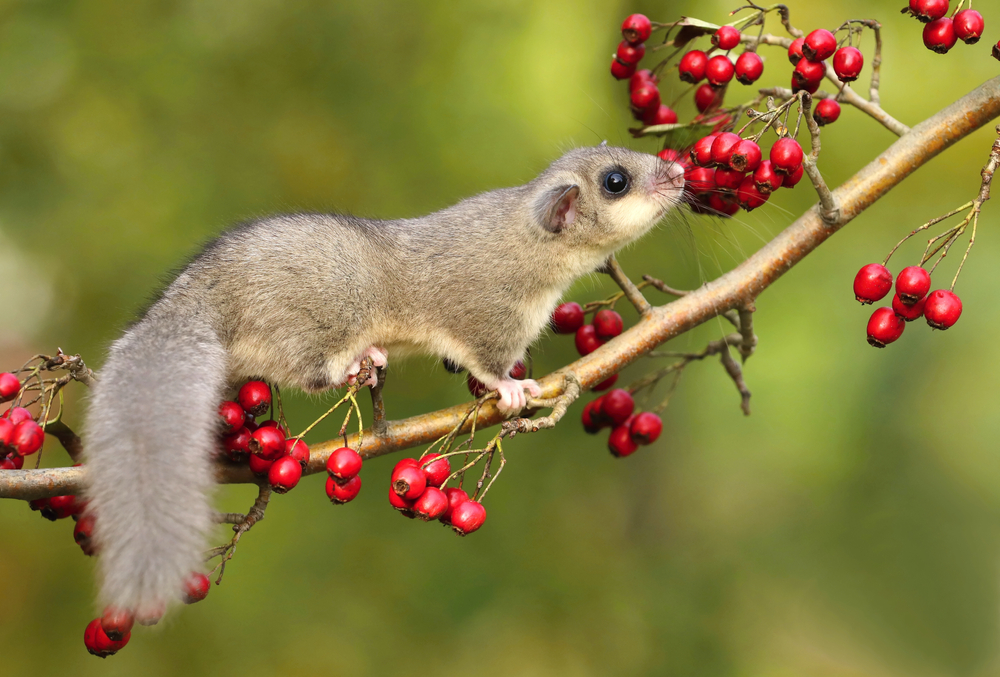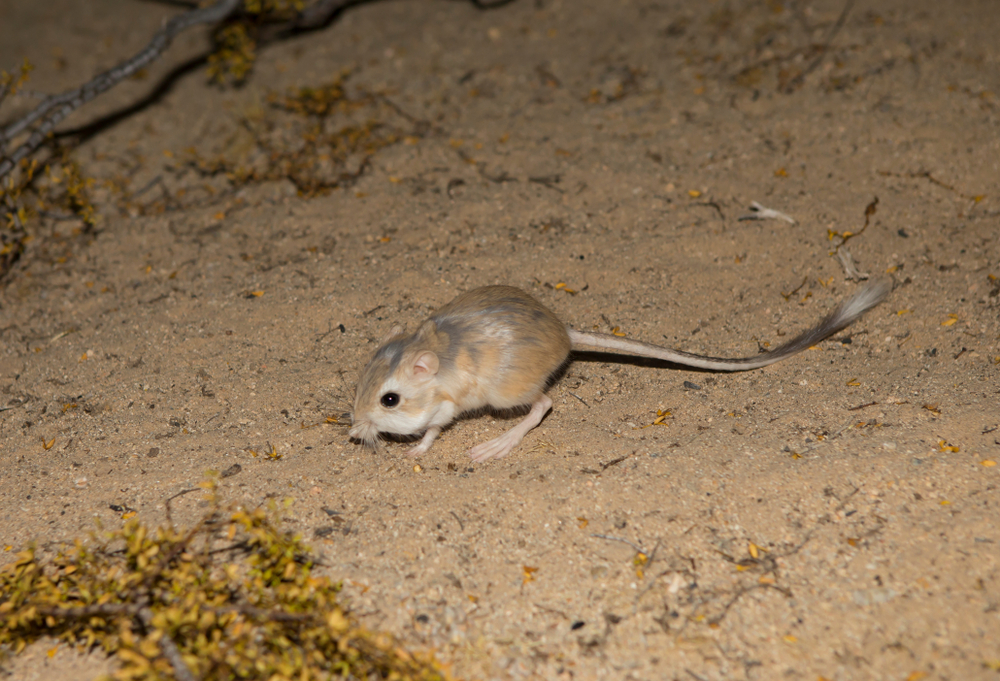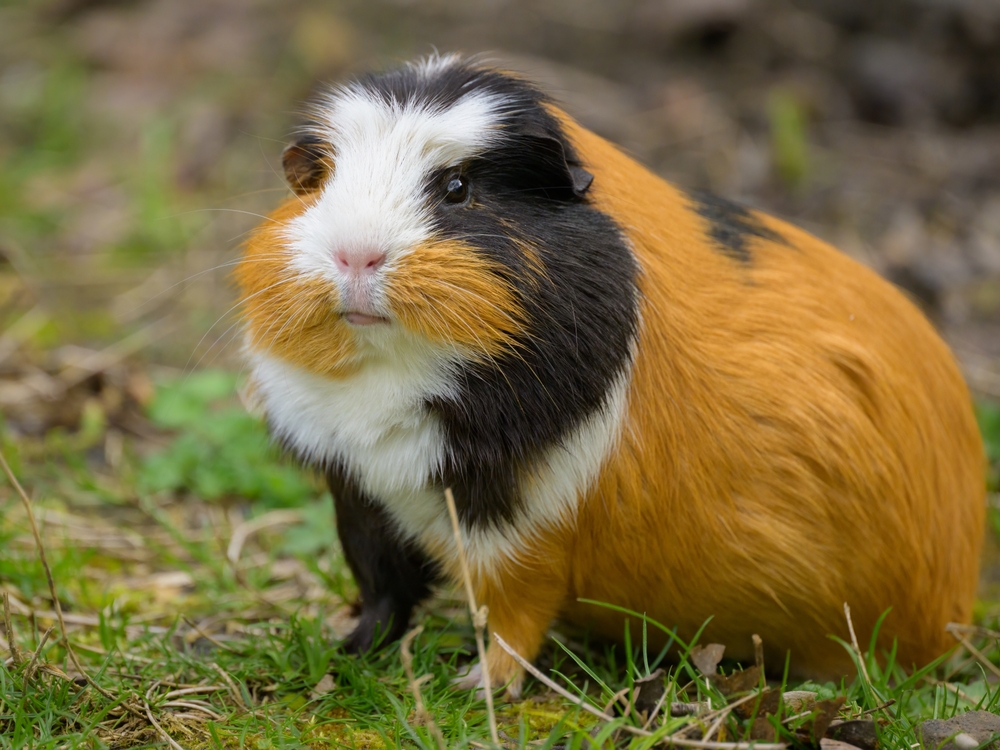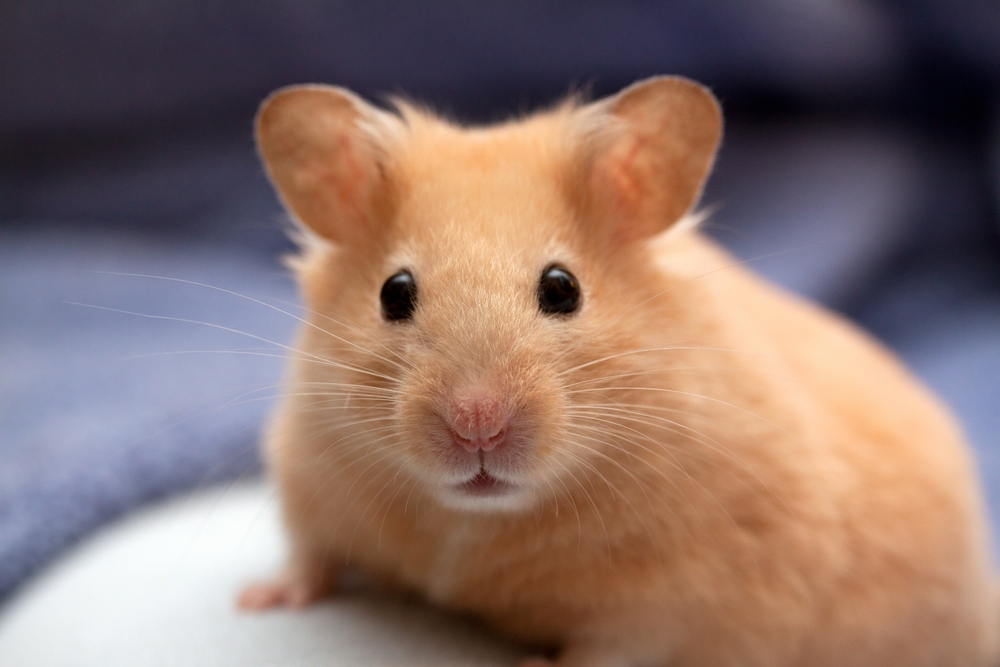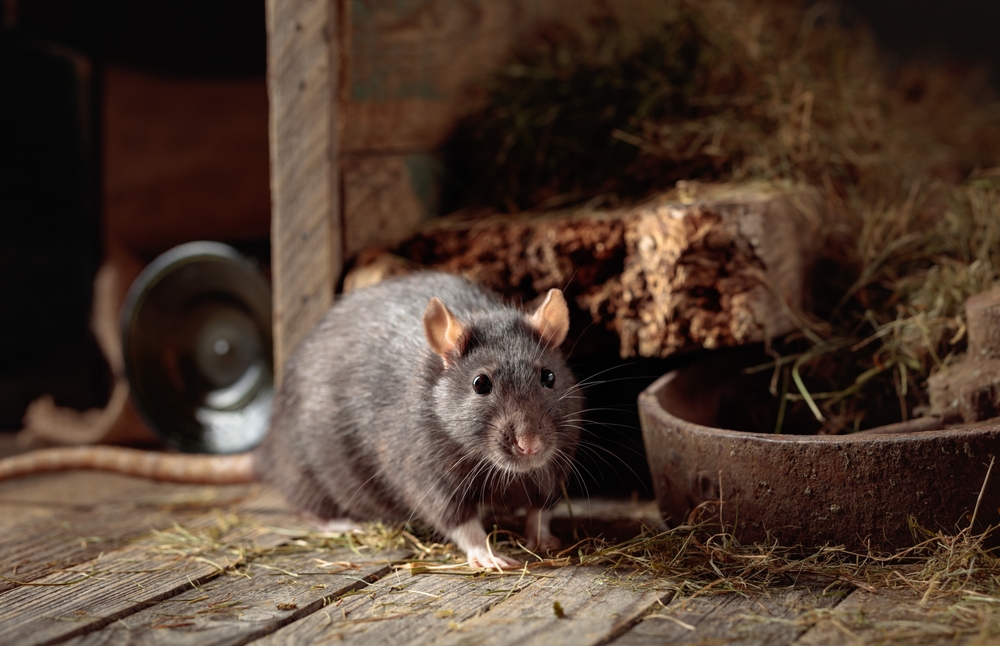The closest relative is the Common Gundi (Ctenodactylus gundi), another North African desert rodent. While both share herbivorous diets, efficient water conservation, and burrowing habits, the Common Gundi has a broader diet and a more rock-dwelling lifestyle, whereas the Fat Sand Rat specializes in saltbush and sandy habitats.
About
The Fat Sand Rat is a burrowing rodent native to the deserts and semi-arid regions of North Africa and the Middle East, including countries such as Egypt, Israel, Saudi Arabia, and Morocco. Belonging to the family Muridae, it is closely related to gerbils and jirds. Despite its name, it is not technically a rat, but a specialized herbivore adapted to harsh desert environments.
Adult Fat Sand Rats measure 25–36 cm (10–14 in) in total length, including a short tail, and typically weigh 200–360 g (7–13 oz). They have a stocky build, sandy-brown fur with lighter underparts, and small ears, all of which help conserve water and regulate body temperature in their hot, dry habitat.
Unlike many desert rodents, the Fat Sand Rat feeds almost exclusively on the leaves and stems of salt-tolerant plants such as saltbush (Atriplex). These plants have high water content but low nutritional value, meaning the animal must consume large quantities daily. This diet provides enough moisture for the Fat Sand Rat to survive without drinking free water.
They live in complex burrow systems that offer shelter from predators, protection from extreme temperatures, and safe nesting sites. They are mostly active during the cooler parts of the day and spend the rest of their time underground.
Interestingly, the Fat Sand Rat is a key species in biomedical research, as it is prone to developing type 2 diabetes when fed a high-calorie diet—making it an important natural model for studying the disease in humans.
The Fat Sand Rat’s scientific name is Psammomys obesus, and it belongs to the family Muridae.
Physical Characteristics
Fur and Coloration:
The Fat Sand Rat has short, dense fur that is sandy brown to grayish-brown on the back, blending well with arid, rocky desert environments. The underparts are pale cream to white. A faint, darker dorsal stripe may run along the spine, and the tail tip is often dark.
Head and Eyes:
The head is broad with a short muzzle and large, black, prominent eyes adapted for sharp vision in bright desert conditions. The ears are small, rounded, and covered in fine hair to minimize heat loss and sand intrusion.
Body:
The body is compact and somewhat stocky, giving it a more robust appearance than many other desert rodents. This heavier build is linked to its high-fat storage capacity, which is reflected in its name.
Legs and Feet:
-
Hind Legs: Shorter than those of bipedal rodents, built for quadrupedal movement rather than hopping.
-
Forelegs: Strong, with sharp claws adapted for digging burrows in sandy or loamy soils.
-
Soles of the feet are fur-covered for insulation from hot ground.
Tail:
Relatively short and covered with fine fur, with a darker tip. The tail is not a major balancing tool like in kangaroo rats but aids in stability during movement.
Size:
-
Body Length: 13–18 cm (5.1–7.1 in)
-
Tail Length: 7–10 cm (2.8–3.9 in)
-
Weight: 150–280 g (5.3–9.9 oz)
Sexual Dimorphism:
Minimal; males and females are similar in size and coloration, although males may be slightly heavier on average.
The Fat Sand Rat’s stocky build, sandy camouflage, and digging adaptations make it well-suited for a life in North Africa and Middle Eastern deserts.
Reproduction
Mating Behavior:
Fat Sand Rats are generally solitary outside of the breeding season. Males seek out females using scent cues, and courtship is brief, consisting of chasing, sniffing, and mounting. Encounters are quick to reduce vulnerability to predators.
Breeding Season:
Breeding typically occurs from late winter through early summer (February to July), but in favorable climates with steady food supply, reproduction may extend into early autumn. Peak breeding coincides with higher availability of green vegetation after seasonal rains.
Gestation and Litter Size:
-
Gestation Period: Approximately 22–24 days.
-
Litter Size: Commonly 3 to 6 pups, but can range from 1 to 8 depending on food availability and maternal health.
-
Multiple litters per year are possible during good resource years.
Nesting:
Birth takes place in underground burrows lined with dry grasses, leaves, and plant fibers. Burrows provide stable temperatures and protect the pups from predators and extreme heat.
Young:
-
Appearance at Birth: Pink, blind, and hairless, fully dependent on the mother.
-
Weaning Age: Around 3–4 weeks.
-
Independence: Juveniles disperse from the natal burrow soon after weaning to establish their own burrows.
Maturity:
Both sexes reach sexual maturity at about 3 months of age, allowing populations to recover quickly when environmental conditions are favorable.
The Fat Sand Rat’s short gestation, ability to produce multiple litters per year, and protective burrow nesting help it thrive in unpredictable desert climates.
Lifespan
Lifespan in the Wild:
In natural desert habitats, Fat Sand Rats generally live 2 to 3 years. Harsh climate conditions, predation, and seasonal food scarcity often limit survival.
Lifespan in Captivity:
With steady food supplies, shelter from predators, and veterinary care, they can live longer.
-
Average Maximum Lifespan: 5 to 6 years in managed care.
Threats to Longevity:
-
Predation: Vulnerable to snakes, birds of prey, foxes, and small carnivores.
-
Harsh Climate: Extreme summer heat, prolonged droughts, and sudden cold snaps can reduce lifespan.
-
Food Availability: Populations fluctuate with the growth cycles of desert vegetation.
-
Human Encroachment: Habitat loss from agriculture and urban development can disrupt burrow systems.
Adaptations for Longevity:
-
Efficient Digging: Strong forelimbs and claws allow them to create deep burrows that offer thermal regulation and predator protection.
-
Herbivorous Specialization: Capable of subsisting almost entirely on the leaves and stems of saltbush and other desert plants.
-
Water Conservation: Like many desert rodents, they extract most of their water from food and have highly efficient kidneys to minimize water loss.
The Fat Sand Rat’s burrowing lifestyle, heat-adapted physiology, and ability to survive on water-rich plants help it endure in some of the harshest desert environments.
Eating Habits
Diet:
The Fat Sand Rat is primarily herbivorous, specializing in desert vegetation.
-
Primary Foods: Leaves and stems of saltbush (Atriplex halimus) and other halophytic (salt-tolerant) plants.
-
Seasonal Variation: In wetter months, they may also consume grasses, seeds, and other green plants.
-
Occasional Foods: Very rarely insects or other plant species when primary food sources are scarce.
Water Acquisition:
-
Obtain nearly all required water from the moisture content of plants consumed.
-
Possess highly efficient kidneys that conserve water by producing concentrated urine.
Feeding Behavior:
-
Forage mainly during the cooler hours of morning and late afternoon to avoid midday desert heat.
-
Stay close to burrow entrances to reduce predation risk while feeding.
-
Often feed in short bursts, collecting plant material and returning to burrow chambers.
Foraging Strategy:
-
Target plants with high water content during dry seasons.
-
Can survive on a very narrow diet, sometimes relying almost exclusively on a single plant species for months at a time.
Adaptations for Feeding:
-
Sharp, chisel-like incisors for cutting through tough, fibrous desert plants.
-
Ability to metabolize salt from halophytic plants without harmful effects.
-
Stocky build supports energy storage in the form of body fat for lean times.
The Fat Sand Rat’s specialized plant diet, salt-tolerant physiology, and water conservation abilities allow it to thrive in arid desert ecosystems where few mammals can survive.
Uniqueness
Plant Specialist Diet:
Unlike many desert rodents with varied diets, the Fat Sand Rat is highly specialized, feeding almost exclusively on saltbush and a few other halophytic plants.
Salt Tolerance:
Possesses a unique physiological adaptation that allows it to metabolize high levels of salt from desert plants without dehydration or organ damage.
Water from Food Only:
Can survive without drinking any free water, obtaining all hydration from moisture-rich plants.
Burrow Climate Control:
Constructs complex underground burrows with multiple chambers that maintain cooler, more humid conditions than the surface, helping conserve water and protect against predators.
Stocky, Energy-Storing Build:
Its compact, rounded body enables fat storage for use during lean seasons, a feature reflected in its name.
Ecological Role:
Plays a key role in desert ecosystems by trimming vegetation, dispersing seeds, and serving as prey for raptors, snakes, and small carnivores.
The Fat Sand Rat’s narrow dietary specialization, salt and water adaptations, and energy-storage physiology make it one of the most uniquely adapted rodents of North African and Middle Eastern deserts.
Be the First to Share Photos of This Species.
FAQ’s
1. What is the closest species to the Fat Sand Rat?
2. How does the Fat Sand Rat compare to other rodents?
The Fat Sand Rat varies from other rodents in a number of ways as seen below:
-
Dietary Specialization: Unlike most rodents, it feeds almost exclusively on a few salt-tolerant plants.
-
Salt and Water Adaptations: Can metabolize high-salt plants without dehydration and survives without drinking free water.
-
Physique: Stockier than many desert rodents, enabling fat storage for lean periods.
-
Movement: Primarily quadrupedal, unlike bipedal desert rodents such as kangaroo rats.
-
Habitat Use: Lives in complex burrow systems for climate control, while some rodents use simpler nests or rock crevices.
3. What national parks provide the best chances to see a Fat Sand Rat?
The Fat Sand Rat is native to arid regions of North Africa and the Middle East. Likely viewing areas include:
-
Sahara Desert fringes within El Kala National Park (Algeria)
-
Bou-Hedma National Park (Tunisia)
-
Tassili n’Ajjer National Park (Algeria)
-
Yotvata Hai-Bar Nature Reserve (Israel)
-
Eilat Mountains Nature Reserve (Israel)
These areas contain the saltbush-dominated habitats the Fat Sand Rat depends on.





































































